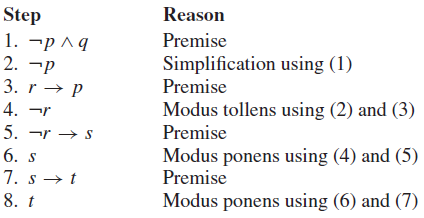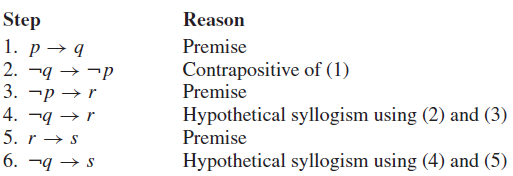SKEDSOFT
Using Rules of Inference to Build Arguments: When there are many premises, several rules of inference are often needed to show that an argument is valid. This is illustrated by Examples 1 and 2, where the steps of arguments are displayed on separate lines, with the reason for each step explicitly stated. These examples also show how arguments in English can be analyzed using rules of inference.
EXAMPLE 1 Show that the premises “It is not sunny this afternoon and it is colder than yesterday,” “We will go swimming only if it is sunny,” “If we do not go swimming, then we will take a canoe trip,” and “If we take a canoe trip, then we will be home by sunset” lead to the conclusion “We will be home by sunset.”
Solution: Let p be the proposition “It is sunny this afternoon,” q the proposition “It is colder than yesterday,” r the proposition “We will go swimming,” s the proposition “We will take a canoe trip,” and t the proposition “We will be home by sunset.” Then the premises become
¬p ∧ q, r → p,¬r → s, and s → t . The conclusion is simply t . We need to give a valid argument with premises ¬p ∧ q, r → p, ¬r → s, and s → t and conclusion t . We construct an argument to show that our premises lead to the desired conclusion as follows.

Note that we could have used a truth table to show that whenever each of the four hypotheses is true, the conclusion is also true. However, because we are working with five propositional variables, p, q, r, s, and t , such a truth table would have 32 rows.
EXAMPLE 2 Show that the premises “If you send me an e-mail message, then I will finish writing the program,” “If you do not send me an e-mail message, then I will go to sleep early,” and “If I go to sleep early, then I will wake up feeling refreshed” lead to the conclusion “If I do not finish writing the program, then I will wake up feeling refreshed.”
Solution: Let p be the proposition “You send me an e-mail message,” q the proposition “I will finish writing the program,” r the proposition “I will go to sleep early,” and s the proposition “I willwake up feeling refreshed.” Then the premises are p → q,¬p → r, and r → s. The desired conclusion is ¬q → s.We need to give a valid argument with premises p → q, ¬p → r, and r → s and conclusion ¬q → s. This argument form shows that the premises lead to the desired conclusion.
